Launched in 2019, the 4.3 MY is the first power model in the Bali range of cruising catamarans built by Catana in southwest France. It reflects the growing market for these spacious boats, as company design engineer Yann Chabaud explained.
The first Bali powercat, the 4.3 MY builds on the success of the French brand’s sailing models; Photos: Bresch & Ludovic Fruchaud for Bali Catamarans / Catana Group
“It was determined right from the start that Bali Catamarans would have a power model, but it took us a few years to develop the uniquely-designed sailing boats that form the heart of our range before we could enter the motor yacht sector.”
Catana’s reputation as the French builder of performance cats took a different tack with the introduction of the Bali series in 2015, which created a range that currently has eight models from the Bali 4.0 (39ft) to the flagship 5.4 (55ft) that impressed me during a recent delivery.
The range has quickly provided successful because it mimicked motorboat features – voluminous, usable space with innovative features such as movable bulkheads and multiple deck access points.
To then follow in the wakes of powercat market leaders Leopard from South Africa and prolific French competitor Fountaine Pajot was never going to be easy, but a natural evolution of the brand.
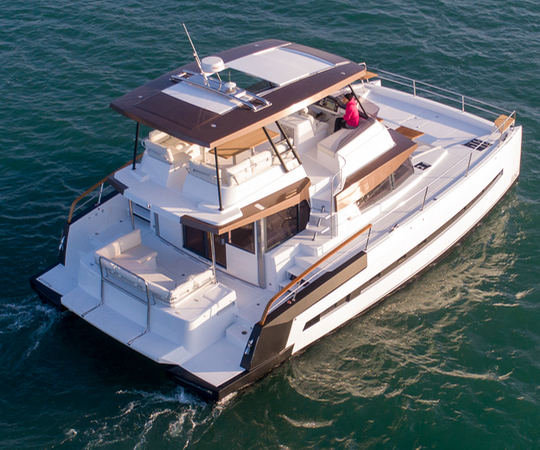
The flybridge with helm is enhanced by access from both sides
“Since our close competitors are making significant sales in this sector, we’d be wrong not to be interested in it,” Chabaud said.
The result: a flybridge cruiser with up to four ensuite cabins and lounge areas fore and aft, plus a vast upper deck. Creating this topside is the easier part of the equation, while transforming a sailing hull shape into an effective motor cruiser is a trickier task.
Some early attempts at this transition have failed, such as Lagoon’s defunct MY40 which delivered only trawler performance in single-digit speeds, while others have bodged some volume into the back ends of hulls in attempts to engender successful planing.
Catana spent three years working on the 4.3 MY and the result is a winning design (which has been joined by the Bali Catspace MY powercat, unveiled at Boot Dusseldorf in January).
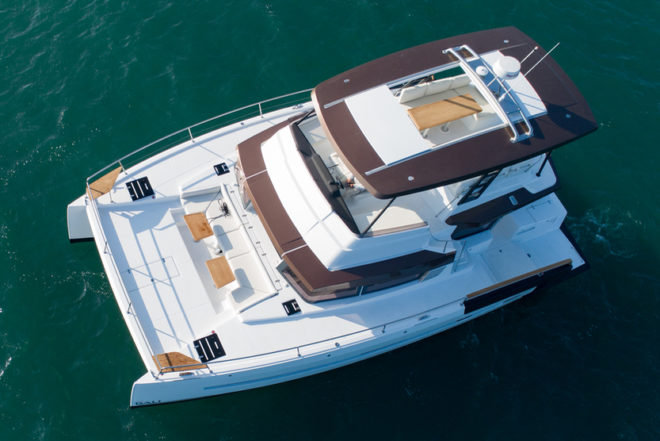
The sunken cockpit on the foredeck is ideal for relaxing or bow riding
Catamaran features include two engines located far apart – unlike a monohull – which gives them incredible manoeuvrability and inbuilt redundancy. This can blur the lines between sailing and power versions. The catamaran design equation is further tweaked by the creation of flybridges, as found on the Bali 4.3 MY and several others from market leaders Lagoon and Fountaine Pajot.
Of course, engines can only do so much for the sailing catamaran style of hulls, but for sailors who want to go cruising and enjoy ample space, the trawler powercat concept is very attractive.
The Bali 4.3 MY flybridge elevates you to see hazards well ahead in the shoal waters found around Asia, something I had wished for when delivering a catamaran through the Arafura Sea a few years ago. The downside of these towering structures is windage, which increases fuel consumption, but handling these high flyers is fairly easy due to the outboard engines that pivot the hulls.
INNOVATIVE FEATURES
Given the stiff competition, Chabaud and fellow designer Oliver Poncin cleverly sought a market differentiator and found it in a word – flexibility – that dictated the approach to the entire Bali range.
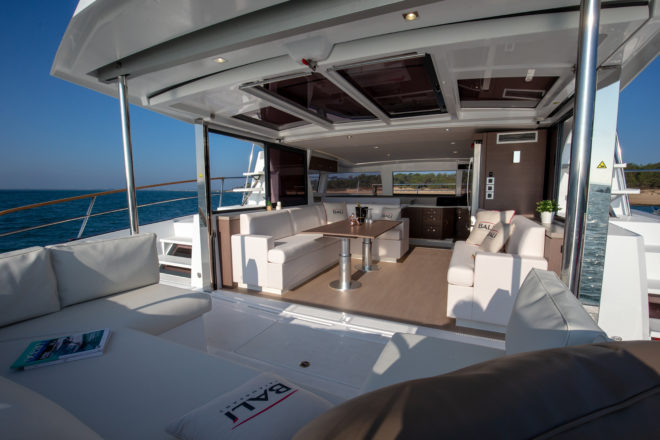
The electric lifting aft bulkhead creates a huge indoor-outdoor area
The main attractions on every Bali include the movable aft bulkhead that creates a vast entertaining space. Other access points around the boat include two sets of stairs to the flybridge, while the walk-around transom on the 4.3 MY is ideal for tropical waters.
Water access is yet another attraction, with a transom platform that can hold an inflatable dinghy on its side and the swim ladder on the port hull. These features, along with the spacious three-level layout, will appeal strongly to both private owners and charter operators.
Looking over the Bali 4.3 MY, it was clear that similar approaches have been taken to how space is maximised on a flybridge catamaran. The result is fairly angular aesthetics that are perhaps more functional than sleek.
Notable features included the voluminous, tall hulls with fine plumb bows running aft to wide transoms, with the latter ideal for carrying heavy cruising loads. The flat decks with flush hatches allow unimpeded walking space, topped off with the high flybridge lounge space.
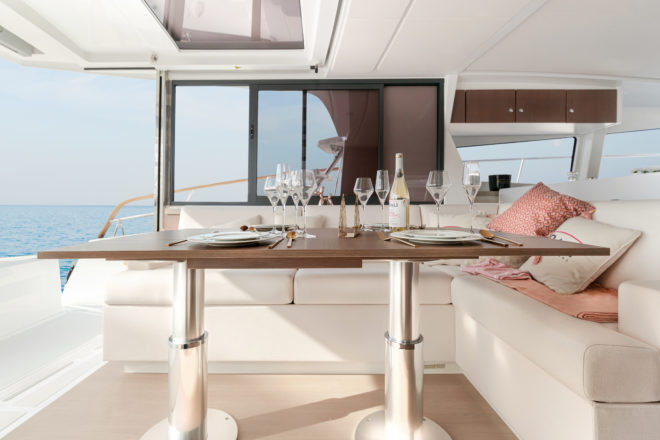
The dining table and main L-shaped sofa are portside, close to the forward galley
The large flybridge has access on two sides and a starboard helm, protected by a discreet but effective windshield. Our review boat was destined for tropical waters, so wisely had the optional fibreglass bimini fitted, which completely shaded the two sets of tables and benches.
Again, this dual use of fittings will appeal to charterers with the added flexibility of being able to change the table height – albeit with rather cumbersome alternate table legs – to create dual sunbeds. Further comforts include the wet bar adjoining the steering console.
At the steering console, the feeling is snug with a compact hydraulic wheel, throttles for the shaft-driven Yanmar 250hps and essential electronics – Raymarine autopilot, plotter and trim tab controls. Another handy system is the anchor counter/control for the 1500w windlass and rode, especially useful when short-handed.
MOVABLE BULKHEAD
On the main deck, the aft area will be a key selling point for prospective buyers, especially those coming from a motorboat background where unimpeded relaxing space is enjoyed. The area is partly shaded by the flybridge extension and seamlessly flows into the saloon at the click of a button that lifts the aft bulkhead upwards.
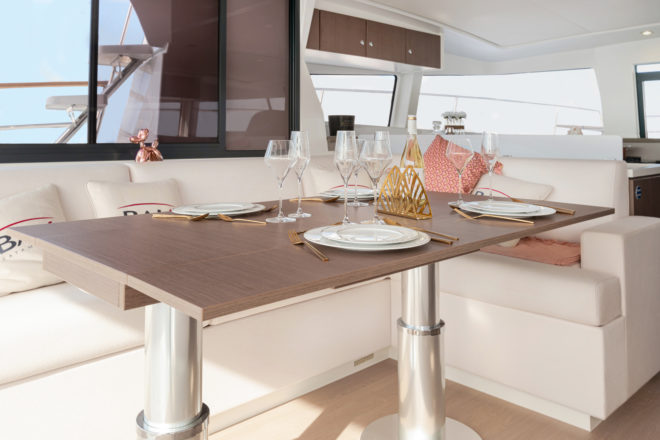
Ahead of the dining table is the galley, ideally placed for serving food
Inside, the saloon is dominated by the longitudinal dinette table surrounded by an L-shaped sofa, while ahead is the galley, ideally placed for serving food. Over to starboard is the elevated steering console, just ahead of the stairs on each side to the hulls. The console has similar controls to the flybridge, and the double helm seat means command need not be a lonely job.
This demarcation cleverly divides the forepart of the saloon for working while leaving the large aft section to flow out into the cockpit or be snugly closed by that movable bulkhead.
Given that the Bali 4.3 MY can sleep eight if four cabins are chosen, catering needs to be on a fairly grand scale and owners won’t be disappointed with the huge household fridge and generous Corian work surfaces around the U-shaped galley and flat space.
Cooking is done on the three-burner gas hob with oven nearby, while barbecue food is put on the electric plate on the transom. Other plus points include the deep double sinks and fiddles around all work surfaces, and good ventilation from the large sliding window at the front.
OWNER’S CABIN
This first hull is an owner’s layout, so the entire port side is a suite and there are two double cabins on the starboard one. Alternatively, for large families or those considering charter, there are four cabins with four bathrooms available – the latter a good achievement for a 42ft hull.
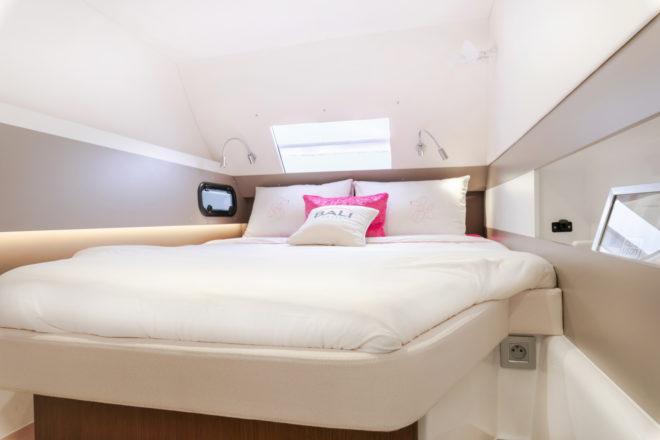
All the double cabins benefit from plenty of natural light
Accessed by steps in the forepart of the saloon, the owner’s suite has the vanity table in the centre, bed aft and large bathroom forward. A single seat at the vanity rather than the preferable two was my only gripe here, but on the upside, it means lots of storage cupboards.
Around the double bed is ample headroom and hatch space, while a large sliding door seals off the area from the saloon. The escape hatch on the hull gives good ventilation, but just remember to close before seagoing!
Similarly, over on starboard, the two cabins are functional, with the stern one having the slightly larger bed but both with ensuite bathrooms, a good reason for the optional water maker.
DECKED OUT
Warm-water boating is largely about alfresco living so generous deck space is essential and another major feature that the entire Bali range was designed around.
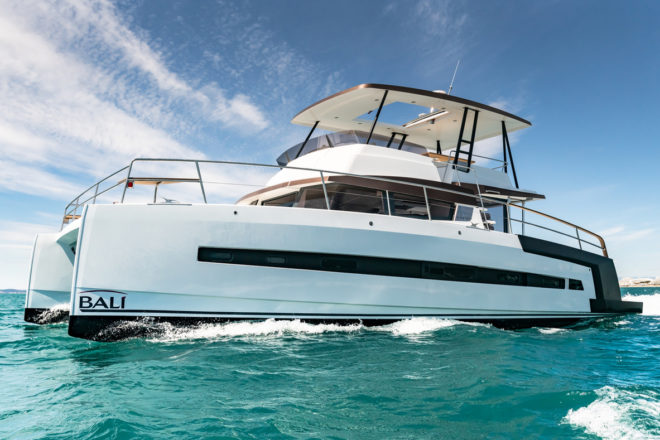
The voluminous, tall hulls feature fine plumb bows
The sunken foredeck cockpit is a wonderful area with benches, two tables and triple sunpads, although the latter require better fastening. Good practicalities here include deep lazarettes and a powerful 1,500w vertical windlass with deep chain locker. The optional generator can go here, to balance the trim.
Catana’s yard, near the foothills of the majestic Pyrenees mountains at Canet-en-Roussillon, uses the latest infused foam moulding system to create a relatively light but strong vessel. Twin mini keels protect the spade rudders behind the shaft-driven propellers, which have small skegs, so in theory the hull can dry out or survive a grounding.
Inside, the engine room on each hull is spacious so can house hot water, air-conditioners and starting batteries with room to spare. All service points – water, oilways, filters – were visible on the Yanmar 4LV250 engines. Based on the Toyota 2.8L turbo intercooled direct injection diesel, accessing parts should be easy anywhere around Asia.
The four-cylinder 4LV250 has the latest common rail fuel injection with electronic engine management, enabling it to operate over a wide range of rpm without worry about cylinder wall glazing under light loads. Its 130amp alternator puts stored power into the triple AGM house batteries deep in the nacelle, so ideally situated for weight distribution to counteract the hefty 800kg of engines at the stern.
Also, here I could see the sturdy steering linkages and quadrants (on stainless shafts), along with the emergency tiller, should the hydraulic steering fail.
MOTORING ON THE MED
Marina manoeuvring is the major source of stress for most boat owners and catamarans are no exception, especially if it’s windy. But with engines located far outboard and judicious use of throttles from the commanding views afforded by the flybridge, we easily pivoted within our own length before making our way past the hundreds of yachts at the largest marina on France’s south coast.
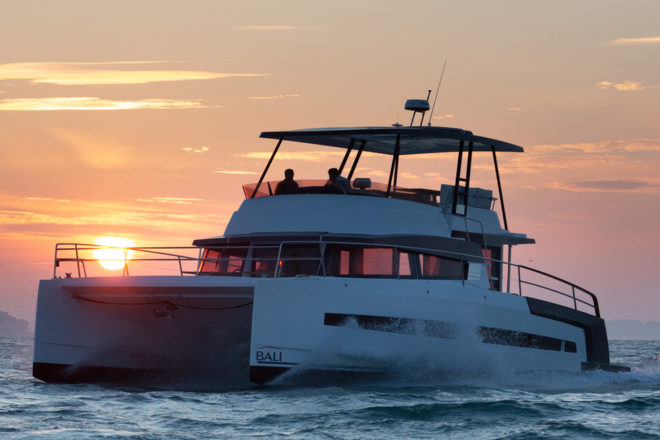
The Bali 4.3 MY had a top speed of 23 knots during the sea trial
A placid Mediterranean Sea welcomed us, despite the stiff breeze blowing offshore, so after making myself snug at the inside helm, I pointed our twin bows towards my favourite islands over the horizon – the Balearics – and put the throttles down.
Acceleration was steady as the dull roar from the twin 250hps put us on the plane at about 14 knots then to 18 knots, which is the optimised cruising speed. The auto trim tabs showed 100 per cent as their vertical fins stabilised our stern and made the ride feel comfortable.
Looking at the numbers on the Yanmar dials, they showed revs of 3,400 and diesel consumption at 80 litres per hour, giving a range of 180 miles. This wasn’t quite the 225 miles needed to reach the Balearics, so I’d consider the optional larger tanks to double this capacity.
Pushing the throttles fully down made a difference as we passed the magic 20 knots and topped-out at nearly 23 knots. Catamarans can’t lean like monohull powerboats, so the downside is larger turning circles, yet the manoeuvres were comfortably completed and without any drinks being spilled, proving that Bali 4.3 MY owners can enjoy the high life wherever they voyage.
www.bali-catamarans.com
Yacht Style Issue 52: Asia’s Top Builders, Reviews & More

